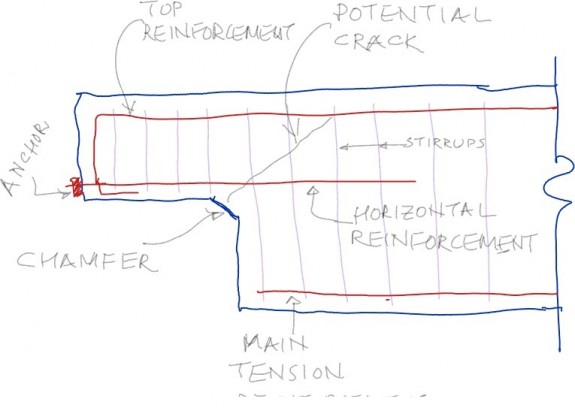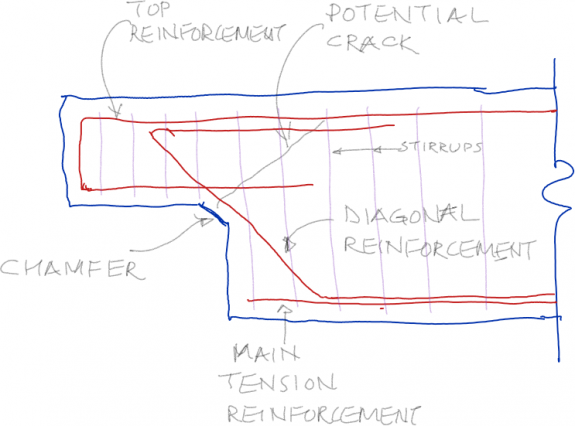| View previous topic::View next topic |
| Author |
Message |
hishamajmalpc
...


Joined: 09 Nov 2015
Posts: 57
|
 Posted: Tue Jan 10, 2023 6:30 am文章主题:对角线强化at reentrant corners Posted: Tue Jan 10, 2023 6:30 am文章主题:对角线强化at reentrant corners |
 |
|
Dear sefinas,
Plz refer to clause 9.4.9 of SP 34 reg. diagonal reinforcement at reentrant corners. Is it necessary to provide this in all cases? Is there any design criteria for this.
regards
 |
|
| Back to top |
|
 |
pvgraju
...

Joined: 07 Jun 2020
Posts: 65
|
 Posted: Tue Jan 17, 2023 9:02 am文章主题:对角线强化at reentrant corners Posted: Tue Jan 17, 2023 9:02 am文章主题:对角线强化at reentrant corners |
 |
|
Dear Sir,
Due to temperature change, shrinkage concrete tries to shrink in perpendicular directions which will cause crack at the corner. By providing diagonal reinforcement at reentrant corners this crack width will get minimized.
Regards,
P.V.Gavarraju. |
|
| Back to top |
|
 |
kunalkansara
General Sponsor

Joined: 26 Jan 2003
Posts: 196
|
 Posted: Wed Mar 08, 2023 10:19 pmPost subject: Posted: Wed Mar 08, 2023 10:19 pmPost subject: |
 |
|
Dear Engineer
What is the structure with the re-entrant corner?
Typically, the re-entrant corners (e.g., in a half-joint or dapped-end in a girder that was a popular approach in bridges constructed in the 60's and 70's) in a structural member are shear-dominant regions. The substantially high stress-concentration at such corners makes them highly prone to the crack originating from the re-entrant corners, through which the elements of nature can enter and initiate corrosion of the internal steel reinforcement and further weaken the member. Few tactics are employed to safeguard the re-entrant corners from this possibility:
Firstly, where possible, instead of a sharp re-entrant corner, chamfers are provided to ease the stress concentration to an extent.
Second, specific reinforcement detailing is provided to tackle stress concentration and forces that intend to crack open the re-entrant corner.
There are two main forms of reinforcement detailing in the re-entrant corners of a structural member :
Option A: (colloquially also known as the European detailing approach), bending up a set of main tension rebars from the bottom face of the belly of the member passing through the re-entrant corner diagonally all the way up to the top face and then bending them inwards to anchor them within the structural member. The crack at the re-entrant corner generally occurs at 45 degrees. So, the key requirement for the diagonal reinforcement is to have sufficient development lengths on either sides of the crack to make it effective in resisting tension which a potential crack is intending to generate in that region.
| Description: |
|
| Filesize: |
67.79 KB |
| Viewed: |
46 Time(s) |

|
| Description: |
|
| Filesize: |
112.03 KB |
| Viewed: |
41 Time(s) |

|
|
|
| Back to top |
|
 |
|
|
|
Youcannotpost new topics in this forum
Youcannotreply to topics in this forum
Youcannotedit your posts in this forum
Youcannotdelete your posts in this forum
Youcannotvote in polls in this forum
Youcannotattach files in this forum
Youcandownload files in this forum
|
|
|